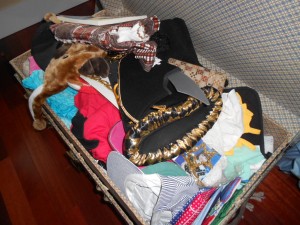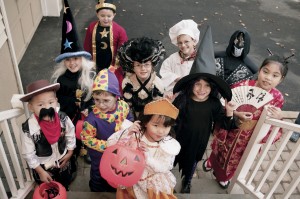Developing kindergarten readiness is the same as helping your child with any new skill; it builds over time with lots of learning and fun. Halloween is an especially fun time of year and many of children’s favorite activities will be ones that are repeated from the years before. (This is not just a sneaky way to cover up doing the same old stuff!) These can be adapted as children grow older but much of the fun is doing things again.
 Opening up the door to the costume trunk can be like opening the door to greet a friend you haven’t seen for awhile. It only took a pair of wee hands a few moments to dig thru these carefully folded items until they became one big pile of colors and texture. As each hat and cape was tried on, so was each character.
Opening up the door to the costume trunk can be like opening the door to greet a friend you haven’t seen for awhile. It only took a pair of wee hands a few moments to dig thru these carefully folded items until they became one big pile of colors and texture. As each hat and cape was tried on, so was each character.
Kids don’t necessarily wait for Halloween to play dress-up. Often, they do it all year long. This pretending and imagining helps with development in many ways. Children test out what they already know to see if it “fits”. For example, as Lee put on the pirate hat and waved the sword, she tried to remember what pirates say. Her first attempt was “Er”, to which I replied “Ar”. She quickly changed her’s to “Arrr” too. As she talked about costume ideas with her mom, she thought she might like to be a whale, but later asked “Mommy, how can I be a whale with feets?” A problem-solving strategy starts with identifying the problem. This skill is another one that kids work on when playing dress-up.
 Besides problem-solving, testing, and imagining, there’s lots of vocabulary to explore, too. What would a firefighter say, or a policeman, or a princess, or an animal? There’s lots of creative thinking, story-telling and emotional learning as well. When children pretend to be somebody else, they also pretend how that somebody else might feel. This is the important skill of empathy that will help kids understand others’ emotions and feelings.
Besides problem-solving, testing, and imagining, there’s lots of vocabulary to explore, too. What would a firefighter say, or a policeman, or a princess, or an animal? There’s lots of creative thinking, story-telling and emotional learning as well. When children pretend to be somebody else, they also pretend how that somebody else might feel. This is the important skill of empathy that will help kids understand others’ emotions and feelings.
Pretending one thing is something else, such as a small box being a robot switch, is called symbolic thinking and this is a foundation for later academic experiences. Kids also practice fine-motor coordination with all the zippers, buttons and different ways of moving in costumes.
What have you noticed kids learning as they play dress-up with Halloween costumes?
